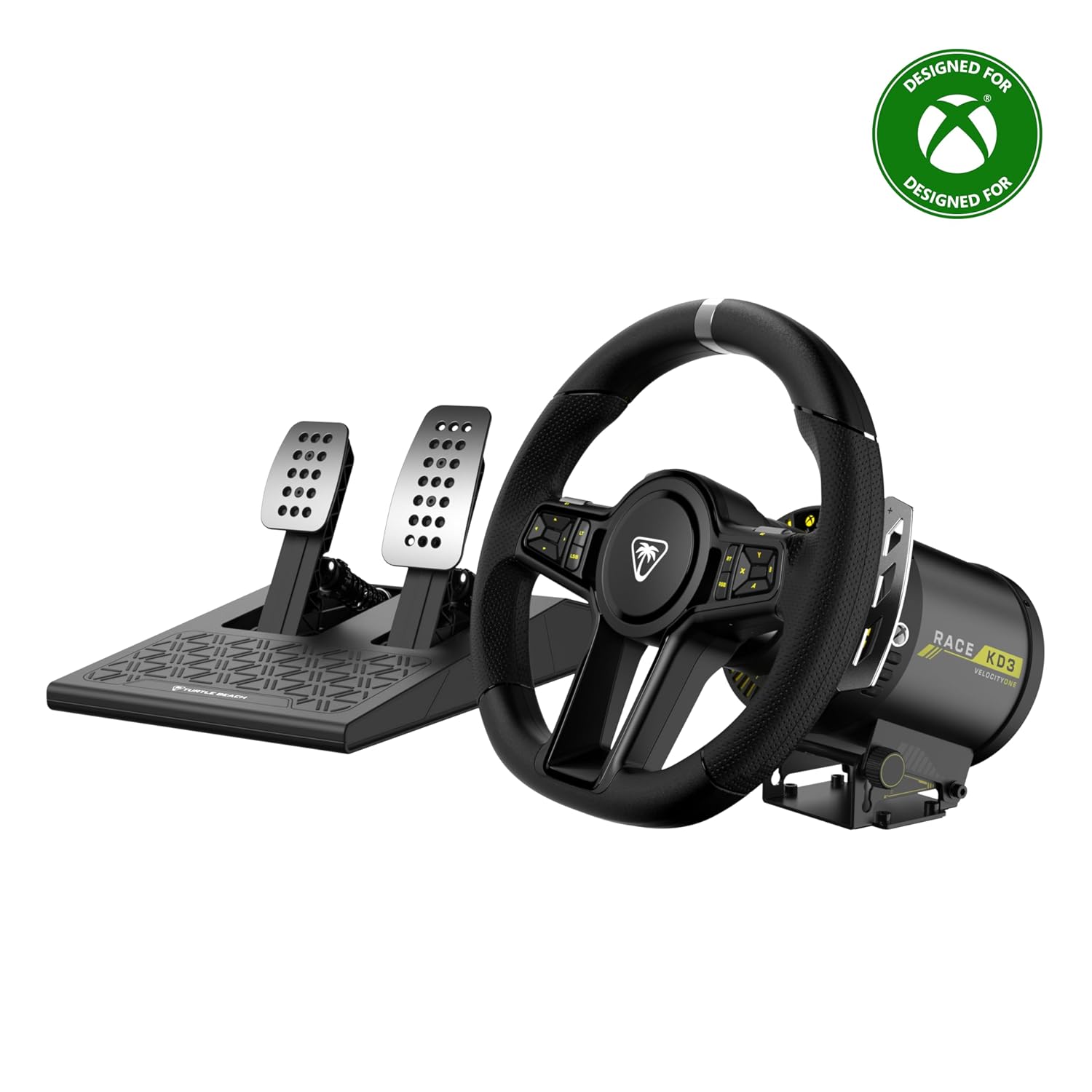Best Sim Racing Wheels [Ultimate Guides]
Best Sim Racing Wheels: Why I wrote this guide (and why I race with a real wheel)
I’ve spent years switching between gamepads, budget wheels and full direct-drive setups — and I write from the perspective of someone who learned that the right wheel changes not only immersion but lap times. This guide explains what sim-racing wheels are, how I shop for one, and which models I’d recommend in 2025 based on hands-on time and what the community keeps recommending.
What are sim racing wheels?
In short: a sim-racing wheel is the complete steering system designed for racing sims — the wheel rim, the wheelbase (motor), and the electronics that deliver force feedback (FFB). They range from inexpensive belt/gear units to high-end direct-drive (DD) bases that attach a metal rim and deliver precise, strong torque. The difference in feel is dramatic: DD wheels transmit subtle tyre information and steering nuances that budget wheels simply can’t reproduce.
Buying guide — how I decide which wheel to buy
1. Define your goals and platform
I always start by asking: am I a casual player who wants immersion, or an aspiring competitor chasing lap time consistency? Console players often need a wheel that explicitly supports their console; PC users have more choices. If you already have a strong wheelbase (or wheel ecosystem like Fanatec), factor upgrade paths into your decision.
2. Torque (Nm) and wheel type: belt/gear vs. direct drive
Torque spec tells you peak force potential, but usable feeling (resolution, smoothness) comes from motor type and controller software. For me, direct-drive bases are worth it once I care about detailed feedback — they feel alive and precise. Entry DD options today make that tier more attainable than a few years ago.
3. Compatibility and ecosystem
Check rim mounts, button layout, console compatibility and whether the brand sells compatible pedals or shifters. If you plan future upgrades, pick an ecosystem that lets you transfer the wheel rim or electronics later.
4. Build quality, mounting and cockpit fit
Wheel stiffness and how the base mounts to your rig matter — a powerful base on a wobbly stand feels terrible. Prioritize a cockpit or wheel stand that supports the torque rating of your chosen base.
5. Budget & value: plan for peripherals
Remember pedals, shifter, handbrake and a proper seat/mounting hardware will add to cost. I often recommend splitting budget: a solid mid-range base + upgradeable pedals beats a cheap base + pro pedals for most people.
Disclosure: This article contains affiliate links. This means that if you click on a link and make a purchase, we may receive a small commission at no additional cost to you.
Best Sim Racing Wheels I Recommend (my tested shortlist)
Below are the wheels I keep recommending or have experience with — I include my own take plus short highlight/useful reviews voiced by family and friends who tested them.
Fanatec GT DD Pro / CSL DD (Fanatec ecosystem)
FANATEC Sim Racing CSL DD QR2 Wheel Base
FANATEC Sim Racing CSL DD QR2 Wheel Base – 5 Nm Direct Drive Base, Dynamic Force Feedback, QR2 Motorsport-Derived Quick-Release System – PC
Check Price on Amazon.comWhy I like it
Fanatec’s DD offerings span entry DD to high-end Podium bases; the GT DD Pro and CSL DD give a strong balance of performance and console compatibility. They’re widely used and easy to expand within the Fanatec ecosystem.
Highlight review
Friend (Ben): “The CSL DD surprised me — torque and clarity that felt worlds apart from my old belt wheel.”
Useful review
Brother (Liam): “If you like to upgrade, Fanatec’s accessories ecosystem makes future swaps painless.”
Simucube 2 family (Sport / Pro / Ultimate)
Simucube 2 Pro Direct Drive Wheel Base – 25Nm High Torque
Simucube 2 Pro Direct Drive Wheel Base – 25Nm High Torque | Ultra-Precision Force Feedback | Professional Sim Racing Equipment
Check Price on Amazon.comWhy I like it
Simucube is consistent in professional sim circles for surgical FFB and rock-solid control. If you want a competition-grade base with ultra-fine tuning, Simucube is the benchmark I look at.
Highlight review
Friend (Carlos): “Simucube feels like the difference between good and pro-level feedback — every bump, kerb and understeer is crisp.”
Useful review
Sister (John): “Expensive, but if you race seriously it’s an all-in kind of buy.”
Thrustmaster T818 / T-GT / T248R (varied tiers)
Thrustmaster T248R, 3.1 N⋅m Force Feedback Racing Wheel and Pedal Set
Thrustmaster T248R, 3.1 N⋅m Force Feedback Racing Wheel and Pedal Set (Compatible with PS5, PS4 and PC)
Check Price on Amazon.comWhy I like it
Thrustmaster offers a wide range: from the proven T-GT and T818 direct drive styles to newly announced mid-range wheels aimed at value buyers. They’re good for console users and those who want dependable performance without breaking the bank.
Highlight review
Brother (An): “Thrustmaster’s wheels give me a great balance of price and feel — my T-GT was a big step up from entry wheels.”
Useful review
Neighbor (Daniel): “Check whether the specific Thrustmaster model supports your console before buying.”
Moza R3 / R5 (budget DD options)
MOZA R5 All-in-One PC Gaming Racing Simulator
MOZA R5 All-in-One PC Gaming Racing Simulator: 5.5Nm Direct Drive Wheel Base, 11-inch Racing Wheel, Anti-Slip Pedals and a Desk Clamp, Cloud-based App Control
Check Price on Amazon.comWhy I like it
Moza’s DD wheelbases have made DD more accessible; the R3 and R5 variants often appear in “best value” lists. For racers wanting genuine DD feedback on a tighter budget, these are worth considering.
Highlight review
Friend (Andy): “I got proper DD feel for less than I expected — excellent entry path to serious FFB.”
Useful review
Sister (Hawk): “Good value, but read reviews on firmware and support before buying.”
Logitech G923 / G29 (budget & casual)
Racing Steering Wheel for Logitech G29/G923 Compatible
Racing Steering Wheel for Logitech G29/G923 Compatible with PlayStation 4/5 and PC Non-slip Grip
Check Price on Amazon.comWhy I like it
Logitech’s older G29/G923 still make sense for beginners or casual players who want a reliable, affordable wheel with pedals included. They won’t match DD finesse but are great first wheels and simple to set up.
Highlight review
Neighbor (Tom): “My first wheel — it made me want to get better at braking and cornering.”
Useful review
Father (Thomas): “Simple, plug-and-play, and kid-friendly.”
New mid-range entrants (example: Turtle Beach KD3 and competitors)
Turtle Beach VelocityOne Race KD3 Direct Drive Force Feedback Racing Wheel
Turtle Beach VelocityOne Race KD3 Direct Drive Force Feedback Racing Wheel & Pedals for Xbox Series X|S, Xbox One & Windows 10/11 PC
Check Price on Amazon.comWhy I like it
2025 saw new companies bring modular or value DD systems to market, offering surprising features at mid price points. These are worth watching if you want modern features without high cost.
Highlight review
Friend (Lena): “I liked how some new models tried to give DD features at lower price points — exciting for new racers.”
Useful review
Brother (Min): “New entrants are promising, but wait for long-term firmware and support impressions before committing.”
How I test wheels (my checklist)
- Mount the base solidly to a cockpit or sturdy stand to avoid flex.
- Drive three types of events: short sprints (precision), endurance (comfort) and traffic/AI packs (consistency).
- Assess pedal integration and whether a load-cell brake is needed.
- Consider long-session comfort — heat, strap fit and whether I need a counterweight for the headrest (many heavy rims need it).
Final thoughts — my personal pick and a short roadmap
For me, a mid-range direct-drive base (CSL DD or GT DD Pro) plus a good load-cell pedal set hit the best balance between performance and cost. If I had infinite budget for a competition rig, Simucube or Fanatec’s top podium bases are where I’d land. If you’re starting out, Logitech or a Thrustmaster mid model will give excellent entry value and help you decide how deep you want to go.

My name is Michael “Mick” Carter, and I’m a dedicated sim racing enthusiast with a deep love for motorsport. I first discovered sim racing in 2015 when a friend introduced me to a Logitech G27 and Assetto Corsa—an experience that immediately hooked me. Since then, I’ve gone from basic gear to advanced direct drive setups, VR headsets, and custom racing rigs, constantly refining my driving technique and equipment.
I mainly race in iRacing, ACC, and rFactor 2, focusing on GT3 endurance and open-wheel events. I’m not a professional driver—I’m simply someone who enjoys the craft of racing: learning car behavior, improving lap times, and battling for position with respect and skill.
I share what I’ve learned so others can build setups they enjoy and grow their own passion for sim racing. For me, the joy is in improving, one race at a time.
Owner at SimRacingCockpits.Com






